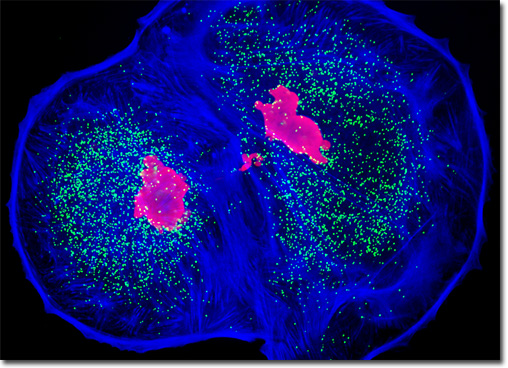Fluorescence Digital Image Gallery
Madin-Darby Ovine Kidney Epithelial Cells (MDOK)
|
Within the body, kidneys are best known for their function in the production and excretion of urine, but also are active in other ways. The organs are, for example, involved in the maintenance of water balance and acid-base balance, as well as the regulation of blood pressure. Moreover, as glands, the kidneys are capable of secreting a variety of substances, such as prostaglandins, renin, and erythropoietin. Through the facilitation of vitamin D conversion into dihydroxy cholecalciferol, the kidneys are also involved in calcium transport. Nuclear histone proteins were targeted in the culture of Madin-Darby ovine kidney cells featured in the digital image above with mouse anti-histone (pan) monoclonal antibodies, which were imaged with goat anti-mouse Fab fragments conjugated to Texas Red (labeling the nucleus). The specimen was simultaneously labeled for peroxisomes with Alexa Fluor 488 conjugated to goat secondary antibodies that target rabbit anti-PMP 70 (peroxisomal membrane protein 70). Alexa Fluor 350 conjugated to phalloidin was utilized to counterstain the cytoskeletal F-actin network. Images were recorded in grayscale with a QImaging Retiga Fast-EXi camera system coupled to an Olympus BX-51 microscope equipped with bandpass emission fluorescence filter optical blocks provided by Omega Optical. During the processing stage, individual image channels were pseudocolored with RGB values corresponding to each of the fluorophore emission spectral profiles. |
© 1995-2025 by Michael W. Davidson and The Florida State University. All Rights Reserved. No images, graphics, software, scripts, or applets may be reproduced or used in any manner without permission from the copyright holders. Use of this website means you agree to all of the Legal Terms and Conditions set forth by the owners.
This website is maintained by our
|
